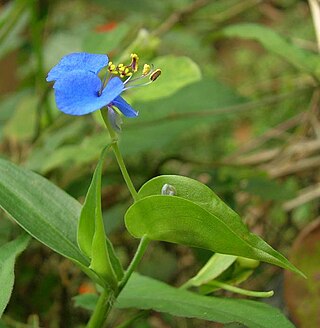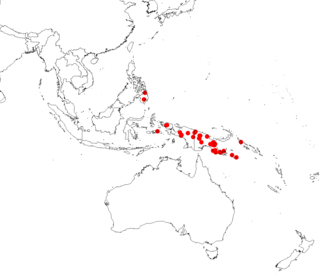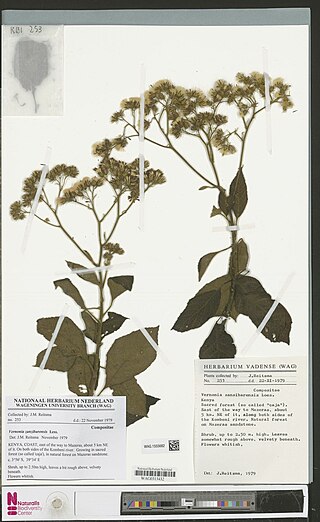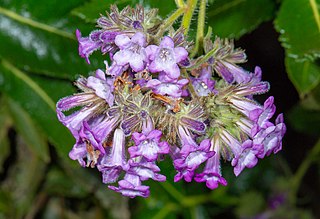
Pachypodium ambongense is a species of plant in the family Apocynaceae. It was first published as a species of the genus Pachypodium in 1924 by the botanist Henri Louis Poisson.

Pachypodium baronii, the Madagascar palm or bontaka, is a flowering plant in the family Apocynaceae. It has the habit of a robust shrub with a spherical or bottle-shaped trunk. It has several cylindrical branches at the top.
Pachypodium bicolor is a species of plant in the family Apocynaceae.

Pachypodium brevicaule is a species of plant that belongs to the family Apocynaceae.
Androstachys johnsonii, the Lebombo ironwood, is a medium-sized Afrotropical tree species, and the sole member of the genus Androstachys in the Picrodendraceae. It is slow-growing, evergreen to deciduous, and dioecious, with flowers that are wind-pollinated. It is native to southeastern Africa and Madagascar, where it generally occurs gregariously on rocky hillsides, particularly in hot and dry situations. It produces a hard, durable wood which is of economic interest. Its specific name commemorates W. H. Johnson, a 19th-century Director of Agriculture in Mozambique. Four related species which are native to Madagascar, are usually placed in genus Stachyandra.

Commelina diffusa, sometimes known as the climbing dayflower or spreading dayflower, is a pantropical herbaceous plant in the dayflower family. It has been introduced to the southeastern United States where it is most common in wet disturbed soils. There are two recognised varieties, one being the type and the other being C. diffusa var. gigas, which is native to Asia and has been introduced to Florida. It flowers from spring to fall and is most common in disturbed situations, moist places and forests. In China the plant is used medicinally as a febrifuge and a diuretic. A blue dye is also extracted from the flower for paints. In the Hawaiian Islands, it is known as "honohono grass", although it is technically not a grass. "Honohono" refers to the alternating structure of the leaves. At least one publication lists it as an edible plant in New Guinea.

Commelina caroliniana, sometimes known as the Carolina dayflower, is an herbaceous plant in the dayflower family native to India and Bangladesh. Both the scientific name and the common name are misleading as the plant was described based on specimens found in the southeastern United States before it was known that the plant had in fact been introduced from India. It was most likely introduced to South Carolina in the late 17th century along with rice seed from India. The plant has also been recently reported from South Korea. Its flowers emerge from summer to fall and rarely into the winter.

Brunfelsia pauciflora is a species of flowering plant in the family Solanaceae, the nightshades. It is endemic to Brazil, and it is grown in cultivation. A shrubby perennial plant grown in gardens, its common names include today, tomorrow together, yesterday, today and tomorrow, morning-noon-and-night, kiss me quick, and Brazil raintree.

Brunfelsia latifolia, commonly known as yesterday-today-tomorrow and kiss me quick, is a species of flowering plant in the nightshade family. Endemic to Brazil, it is an evergreen shrub that becomes semi-deciduous in cooler areas and grows up to 1.8 meters in height.

Passiflora bogotensis is a climbing plant native to Colombia, in the genus Passiflora. It can also be found in Venezuela.

Felicia heterophylla is a roughly hairy annual plant in the family Asteraceae. It has alternate leaves of 1–5 cm long with an entire margin or few inconspicuous teeth. The flower heads are set individually at the tip of its stems, and contain a whorl of purplish blue ray florets around a center of blackish blue disk florets. Flower heads appear in winter and spring. It is called true-blue daisy in English and bloublomastertjie in Afrikaans. It is an endemic species that only occurs in the Western Cape province of South Africa.

Parsonsia curvisepala is a woody vine of the family Apocynaceae, found in Malaysia, New Guinea, the Philippines, the Solomon Islands, and Sulawesi. This species is second only to Parsonsia alboflavescens in its variability and wide geographic distribution.

Mairia coriacea is a perennial plant assigned to the family Asteraceae. It has broad, tough and leathery, evergreen leaves. These have a narrowed foot and an entire margin or a few shallow, irregular teeth. They grow in a rosette directly from the rootstock. The plant produces flower heads with one whorl of white to mauve ray florets around many yellow disc florets, with one or few on top of a dark reddish, woolly stalk. Flower heads appear after the overhead vegetation burnt down, often destroying the leaves in the process. It can be found in the southern mountains of South Africa's Western Cape province. It is called leather leaves in English.

Mairia petiolata is a tufted, variably hairy, perennial plant of up to 15 cm (6 in) assigned to the family Asteraceae. Its leaves are in a ground rosette, and have a stalk of mostly 2–5 cm long and an inverted egg-shaped to elliptic, 61⁄2–9 cm (2.6–4.6 in) long and 2–3 cm wide leaf blade, with a toothed margin. It mostly has two flower heads at the tip of the branches of each erect, dark reddish brown scape. The flower heads have a bell- to cup-shaped involucre that consists of 20–24, purplish, overlapping bracts in 3–4 whorls. These protect 12–16 pink, ray florets, surrounding many yellow disc florets. This species was only seen flowering once, in December. It is known from one location in the Langeberg, Western Cape province of South Africa.

Mairia robusta is a tufted, white-woolly, perennial, herbaceous plant of up to 30 cm (1 ft) high, that is assigned to the family Asteraceae. It has large, robust, hard and leathery leaves, with a white woolly hairy, nontransparent underside, while the felty hairs on the top are lost with age. Only at a few occasions, flowers have been observed, in June, October and December, always after a fire. The flower heads sit individually at the tip of white-woolly scapes, with 14–16 purplish pink to white ray florets surrounding a yellow disc. M. robusta is an endemic species that is restricted to rocky mountain slopes in the Western Cape province of South Africa.
Physalis latiphysa is a herbaceous plant that grows to a height of 30 to 45 cm. The shoot axis is densely hairy with multicellular, glandular trichomes. The leaves are silky and hairy, 5.5 to 16.0 cm long, with petioles 2.5 to 7.5 cm and leaf blades 3.0 to 8.5 cm. The leaf blade has a width of 1.5 to 7.0 cm, the tip is tapering, the base is blunt, rarely skewed by up to 3 mm. The leaf margin is entire or rarely serrated with up to four teeth per side.
Hoffmannanthus is a monotypic genus of flowering plants in the Asteraceae. There is only one known species, Hoffmannanthus abbotianus(O.Hoffm.) H.Rob., S.C.Keeley & Skvarla Its native range is Uganda and southern Tropical Africa. It is found in the countries of Angola, Kenya, Tanzania, Uganda, Zambia and Zaïre.

Jeffreycia is a genus of African flowering plants in the family Asteraceae. They are in the tribe Vernonieae.

Eriodictyon sessilifolium, known by the common names Baja California yerba santa, sessile-leaved yerba santa or sessileleaf yerba santa is a perennial shrub in the Boraginaceae family, near-endemic to Baja California but also rarely found in the southern California, in a locality near Poway.

Wachendorfia brachyandra is a small to large, 10–65 cm (3.9–25.6 in) high, winter-growing, perennial herbaceous plant that grows from a rootstock, and has been assigned to the bloodroot family. Its simple, entire, line- to lance-shaped leaves that are usually shorter than the stem, and have pleated, laterally flattened leaf blades af about 35 mm (1.4 in) wide, meaning that there are left and right surfaces rather than upper and lower. The inflorescence is a lax panicle and at the base of each flowerstalk is a dry, brown and papery bract, and those higher in the panicle have a recurved tip. The mirror-symmetrical pale apricot-yellow flowers consist of six tepals and are adorned with brown markings on the upper three tepals. There are three anthers that are clustered and about half as long as the tepals. Each individual flower only lasts one day. Flowering occurs from August to December. This species grows in the wild in the Western Cape province of South Africa only, and is much less common than its relatives W. paniculata and W. thyrsiflora. It is sometimes called short-stamen butterfly-lily in English.

















